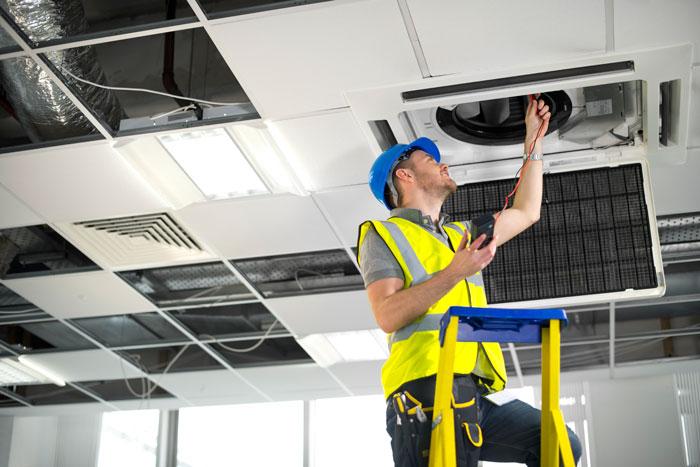TM44 Inspection of Air Conditioning Systems For Your Property
TM44 Inspections for Buildings in the UK
Importance of TM44 Inspections for Buildings in the UK
TM44 inspections are a vital part of maintaining energy efficiency in buildings across the UK. These inspections focus on the air conditioning systems within a building, ensuring they are operating efficiently and in compliance with legal requirements.
Energy efficiency is a key concern for buildings, as it not only reduces costs for owners and tenants but also contributes to a greener environment by lowering carbon emissions. TM44 inspections play a crucial role in this by identifying areas for improvement and recommending changes to enhance efficiency.
By understanding the purpose and process of TM44 inspections, building owners can take proactive steps toward creating more sustainable and cost-effective buildings.
What Is a TM44 Inspection?
A TM44 inspection is an assessment of the efficiency of air conditioning systems in buildings. These inspections are required by law for all air-conditioned buildings with a cooling capacity of over 12kW. The purpose of a TM44 inspection is to ensure that air conditioning systems are energy-efficient and not wasting energy, which contributes to the overall carbon footprint of the building.
In the UK, the Energy Performance of Buildings Regulations 2012 (England and Wales) and the Energy Performance of Buildings (Scotland) Regulations 2008 (as amended) require that all air-conditioned buildings undergo a TM44 inspection every five years. Failure to comply with these regulations can result in fines and penalties.
TM44 inspections must be carried out by an accredited air conditioning energy assessor. These assessors are trained and certified to conduct TM44 inspections and provide recommendations for improving the efficiency of air conditioning systems.
How Does a TM44 Inspection Work?
During a TM44 inspection, the accredited assessor will evaluate the air conditioning systems within the building. This includes examining the size and condition of the systems, as well as their controls and settings. The assessor will also review maintenance records and any previous TM44 inspection reports to assess the system’s performance over time.
Key components examined during the inspection include the efficiency of the systems, the amount of refrigerant used, and the control of the systems. The assessor will also assess whether the systems are suitably sized for the building and if they are being operated efficiently.
The duration of a TM44 inspection can vary depending on the size and complexity of the building’s air conditioning systems. However, most inspections can be completed within a day. After the inspection, the assessor will provide a report detailing their findings and recommendations for improving the efficiency of the systems.
What Is Required for a TM44 Inspection?
Prior to a TM44 inspection, building owners or managers must gather relevant documentation and information. This includes the building’s floor plans, air conditioning system specifications, maintenance records, and any previous TM44 inspection reports. This information helps the assessor understand the layout and operation of the building’s air conditioning systems.
Inspectors conducting TM44 inspections require access to all parts of the building that contain air conditioning systems, including plant rooms, equipment rooms, and individual units. Access must be provided to all components of the air conditioning systems, such as outdoor units, indoor units, controls, and any associated documentation.
After the TM44 inspection is complete, building owners or managers are required to comply with any recommendations provided by the assessor. These recommendations are aimed at improving the energy efficiency of the building’s air conditioning systems and may include actions such as adjusting settings, upgrading equipment, or implementing maintenance procedures.
The Importance of TM44 Inspections
TM44 inspections play a crucial role in enhancing the energy efficiency of buildings, which offers several significant benefits. One of the primary advantages is the reduction in energy consumption, leading to lower utility bills for building owners and tenants. By identifying and rectifying inefficiencies in air conditioning systems, TM44 inspections can result in substantial cost savings over time.
Moreover, energy-efficient buildings have a lower environmental impact, as they consume less energy and produce fewer carbon emissions. This aligns with the UK’s commitment to reducing its carbon footprint and combating climate change. TM44 inspections contribute to this goal by promoting sustainable practices in building management.
From a legal perspective, TM44 inspections are mandatory for air-conditioned buildings in the UK with a cooling capacity of over 12kW. Failure to comply with these regulations can result in fines and penalties. Therefore, TM44 inspections are essential for building owners and managers to ensure compliance with relevant legislation.
In addition to financial and legal benefits, TM44 inspections can improve the comfort and productivity of building occupants. Well-maintained and efficient air conditioning systems create a more comfortable indoor environment, which can positively impact occupant satisfaction and work performance. This is particularly important in commercial buildings, where occupant comfort and productivity are key priorities.
TM44 inspections are a valuable tool for improving the energy efficiency of buildings in the UK. They offer a range of benefits, including cost savings, environmental protection, legal compliance, and enhanced occupant comfort and productivity.
TM44 Inspections in the UK
In the UK, TM44 inspections are a legal requirement for air-conditioned buildings with a cooling capacity of over 12kW. The regulations governing TM44 inspections are part of the Energy Performance of Buildings Directive, aimed at improving energy efficiency and reducing carbon emissions in buildings.
TM44 inspections have had a significant impact on the built environment in the UK. By identifying and rectifying inefficiencies in air conditioning systems, these inspections have contributed to reduced energy consumption and lower carbon emissions. They have also helped raise awareness about the importance of energy efficiency among building owners and managers.
Looking ahead, future trends in TM44 inspections are likely to focus on technological advancements and data analytics. These developments will enable more detailed and accurate assessments of air conditioning systems, leading to further improvements in energy efficiency.
Conclusion
TM44 inspections play a crucial role in promoting energy efficiency and sustainability in buildings in the UK. By identifying areas for improvement and recommending changes, these inspections help reduce energy consumption, lower costs, and protect the environment.
Building owners and managers are encouraged to comply with TM44 regulations to reap the benefits of improved energy efficiency and legal compliance. By investing in TM44 inspections and implementing the recommended improvements, building owners can create more sustainable buildings that benefit both the environment and occupants.
TM44 inspections are essential for achieving the UK’s goals for Net Zero emissions by 2050. They will continue to play a vital role in promoting sustainable buildings and reducing the environmental impact of the built environment.
TM44 Inspection Quote

- We Are Here To Help You 0800 917 4026
- Buy Securely Online with PayPal
- Read Genuine Customer Reviews
- Trustmark™ Trading Standard Approved
Get Your TM44 Air Con Quote:
"*" indicates required fields




